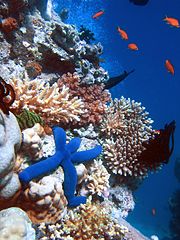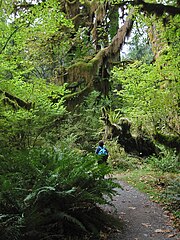Ecosystem
| Part of a series on |
| Biology |
|---|
Anecosystem(orecological system) is a system thatenvironmentsand theirorganismsform through their interaction.[2]: 458 Thebioticandabiotic componentsare linked together throughnutrient cyclesandenergyflows.
Ecosystems are controlled by external and internalfactors.External factors such asclimate,parent materialwhich forms the soil andtopography,control the overall structure of an ecosystem but are not themselves influenced by the ecosystem. Internal factors are controlled, for example, bydecomposition,root competition, shading, disturbance, succession, and the types of species present. While theresourceinputs are generally controlled by external processes, the availability of these resources within the ecosystem is controlled by internal factors. Therefore, internal factors not only control ecosystem processes but are also controlled by them.
Ecosystems aredynamicentities—they are subject to periodic disturbances and are always in the process of recovering from some past disturbance. The tendency of an ecosystem to remain close to its equilibrium state, despite that disturbance, is termed itsresistance.The capacity of a system to absorb disturbance and reorganize while undergoing change so as to retain essentially the same function, structure, identity, and feedbacks is termed itsecological resilience.Ecosystems can be studied through a variety of approaches—theoretical studies, studies monitoring specific ecosystems over long periods of time, those that look at differences between ecosystems to elucidate how they work and direct manipulative experimentation.Biomesare general classes or categories of ecosystems. However, there is no clear distinction between biomes and ecosystems.Ecosystem classificationsare specific kinds of ecological classifications that consider all four elements of the definition ofecosystems:a biotic component, anabioticcomplex, the interactions between and within them, and the physical space they occupy. Biotic factors of the ecosystem are living things; such as plants, animals, and bacteria, while abiotic are non-living components; such as water, soil and atmosphere.
Plants allow energy to enter the system throughphotosynthesis,building up plant tissue. Animals play an important role in the movement ofmatterand energy through the system, by feeding on plants and on one another. They also influence the quantity of plant andmicrobialbiomasspresent. By breaking down deadorganic matter,decomposersreleasecarbonback to the atmosphere and facilitatenutrient cyclingby converting nutrients stored in dead biomass back to a form that can be readily used by plants and microbes.
Ecosystems provide a variety of goods and services upon which people depend, and may be part of. Ecosystem goods include the "tangible, material products" of ecosystem processes such as water, food, fuel, construction material, andmedicinal plants.Ecosystem services,on the other hand, are generally "improvements in the condition or location of things of value". These include things like the maintenance ofhydrological cycles,cleaning air and water, the maintenance of oxygen in the atmosphere, croppollinationand even things like beauty, inspiration and opportunities for research. Many ecosystems become degraded through human impacts, such assoil loss,airandwater pollution,habitat fragmentation,water diversion,fire suppression,andintroduced speciesandinvasive species.These threats can lead to abrupt transformation of the ecosystem or to gradual disruption of biotic processes and degradation ofabioticconditions of the ecosystem. Once the original ecosystem has lost its defining features, it is considered"collapsed".Ecosystem restorationcan contribute to achieving theSustainable Development Goals.
Definition
An ecosystem (or ecological system) consists of all the organisms and the abiotic pools (or physical environment) with which they interact.[3][4]: 5 [2]: 458 The biotic andabiotic componentsare linked together through nutrient cycles and energy flows.[5]
"Ecosystem processes" are the transfers of energy and materials from one pool to another.[2]: 458 Ecosystem processes are known to "take place at a wide range of scales". Therefore, the correct scale of study depends on the question asked.[4]: 5
Origin and development of the term
The term "ecosystem" was first used in 1935 in a publication by British ecologistArthur Tansley.The term was coined byArthur Roy Clapham,who came up with the word at Tansley's request.[6]Tansley devised the concept to draw attention to the importance of transfers of materials between organisms and their environment.[4]: 9 He later refined the term, describing it as "The whole system,... including not only the organism-complex, but also the whole complex of physical factors forming what we call the environment".[3]Tansley regarded ecosystems not simply as natural units, but as "mental isolates".[3]Tansley later defined the spatial extent of ecosystems using the term "ecotope".[7]
G. Evelyn Hutchinson,alimnologistwho was a contemporary of Tansley's, combinedCharles Elton's ideas abouttrophicecology with those of Russian geochemistVladimir Vernadsky.As a result, he suggested that mineral nutrient availability in a lake limitedalgal production.This would, in turn, limit the abundance of animals that feed on algae.Raymond Lindemantook these ideas further to suggest that the flow of energy through a lake was the primary driver of the ecosystem. Hutchinson's students, brothersHoward T. OdumandEugene P. Odum,further developed a "systems approach" to the study of ecosystems. This allowed them to study the flow of energy and material through ecological systems.[4]: 9
Processes


External and internal factors
Ecosystems are controlled by both external and internal factors. External factors, also called state factors, control the overall structure of an ecosystem and the way things work within it, but are not themselves influenced by the ecosystem. On broad geographic scales,climateis the factor that "most strongly determines ecosystem processes and structure".[4]: 14 Climate determines thebiomein which the ecosystem is embedded. Rainfall patterns and seasonal temperatures influence photosynthesis and thereby determine the amount of energy available to the ecosystem.[8]: 145
Parent materialdetermines the nature of the soil in an ecosystem, and influences the supply of mineral nutrients.Topographyalso controls ecosystem processes by affecting things likemicroclimate,soil development and the movement of water through a system. For example, ecosystems can be quite different if situated in a small depression on the landscape, versus one present on an adjacent steep hillside.[9]: 39 [10]: 66
Other external factors that play an important role in ecosystem functioning include time and potentialbiota,the organisms that are present in a region and could potentially occupy a particular site. Ecosystems in similar environments that are located in different parts of the world can end up doing things very differently simply because they have different pools of species present.[11]: 321 Theintroduction of non-native speciescan cause substantial shifts in ecosystem function.[12]
Unlike external factors, internal factors in ecosystems not only control ecosystem processes but are also controlled by them.[4]: 16 While theresourceinputs are generally controlled by external processes like climate and parent material, the availability of these resources within the ecosystem is controlled by internal factors like decomposition, root competition or shading.[13]Other factors like disturbance, succession or the types of species present are also internal factors.
Primary production
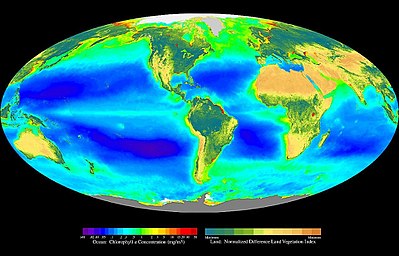
Primary production is the production oforganic matterfrom inorganic carbon sources. This mainly occurs throughphotosynthesis.The energy incorporated through this process supports life on earth, while the carbon makes up much of the organic matter in living and dead biomass,soil carbonandfossil fuels.It also drives thecarbon cycle,which influences globalclimatevia thegreenhouse effect.
Through the process of photosynthesis, plants capture energy from light and use it to combinecarbon dioxideand water to producecarbohydratesandoxygen.The photosynthesis carried out by all the plants in an ecosystem is called the gross primary production (GPP).[8]: 124 About half of the gross GPP is respired by plants in order to provide the energy that supports their growth and maintenance.[14]: 157 The remainder, that portion of GPP that is not used up by respiration, is known as thenet primary production(NPP).[14]: 157 Total photosynthesis is limited by a range of environmental factors. These include the amount of light available, the amount ofleafarea a plant has to capture light (shading by other plants is a major limitation of photosynthesis), the rate at which carbon dioxide can be supplied to thechloroplaststo support photosynthesis, the availability of water, and the availability of suitable temperatures for carrying out photosynthesis.[8]: 155
Energy flow
Energyandcarbonenter ecosystems through photosynthesis, are incorporated into living tissue, transferred to other organisms that feed on the living and dead plant matter, and eventually released through respiration.[14]: 157 The carbon and energy incorporated into plant tissues (net primary production) is either consumed by animals while the plant is alive, or it remains uneaten when the plant tissue dies and becomesdetritus.Interrestrial ecosystems,the vast majority of the net primary production ends up being broken down bydecomposers.The remainder is consumed by animals while still alive and enters the plant-based trophic system. After plants and animals die, the organic matter contained in them enters the detritus-based trophic system.[15]
Ecosystem respirationis the sum ofrespirationby all living organisms (plants, animals, and decomposers) in the ecosystem.[16]Net ecosystem productionis the difference betweengross primary production(GPP) and ecosystem respiration.[17]In the absence of disturbance, net ecosystem production is equivalent to the net carbon accumulation in the ecosystem.
Energy can also be released from an ecosystem through disturbances such aswildfireor transferred to other ecosystems (e.g., from a forest to a stream to a lake) byerosion.
Inaquatic systems,the proportion of plant biomass that gets consumed byherbivoresis much higher than in terrestrial systems.[15]In trophic systems, photosynthetic organisms are the primary producers. The organisms that consume their tissues are called primary consumers orsecondary producers—herbivores.Organisms which feed onmicrobes(bacteriaandfungi) are termedmicrobivores.Animals that feed on primary consumers—carnivores—are secondary consumers. Each of these constitutes a trophic level.[15]
The sequence of consumption—from plant to herbivore, to carnivore—forms afood chain.Real systems are much more complex than this—organisms will generally feed on more than one form of food, and may feed at more than one trophic level. Carnivores may capture some prey that is part of a plant-based trophic system and others that are part of a detritus-based trophic system (a bird that feeds both on herbivorous grasshoppers and earthworms, which consume detritus). Real systems, with all these complexities, formfood websrather than food chains.[15]
Decomposition

The carbon and nutrients indead organic matterare broken down by a group of processes known as decomposition. This releases nutrients that can then be re-used for plant and microbial production and returns carbon dioxide to the atmosphere (or water) where it can be used for photosynthesis. In the absence of decomposition, the dead organic matter would accumulate in an ecosystem, and nutrients and atmospheric carbon dioxide would be depleted.[18]: 183
Decomposition processes can be separated into three categories—leaching,fragmentation and chemical alteration of dead material. As water moves through dead organic matter, it dissolves and carries with it the water-soluble components. These are then taken up by organisms in the soil, react with mineral soil, or are transported beyond the confines of the ecosystem (and are considered lost to it).[19]: 271–280 Newly shed leaves and newly dead animals have high concentrations of water-soluble components and includesugars,amino acidsand mineral nutrients. Leaching is more important in wet environments and less important in dry ones.[10]: 69–77
Fragmentation processes break organic material into smaller pieces, exposing new surfaces for colonization by microbes. Freshly shedleaf littermay be inaccessible due to an outer layer ofcuticleorbark,andcell contentsare protected by acell wall.Newly dead animals may be covered by anexoskeleton.Fragmentation processes, which break through these protective layers, accelerate the rate of microbial decomposition.[18]: 184 Animals fragment detritus as they hunt for food, as does passage through the gut.Freeze-thaw cyclesand cycles of wetting and drying also fragment dead material.[18]: 186
The chemical alteration of the dead organic matter is primarily achieved through bacterial and fungal action. Fungalhyphaeproduce enzymes that can break through the tough outer structures surrounding dead plant material. They also produce enzymes that break downlignin,which allows them access to both cell contents and the nitrogen in the lignin. Fungi can transfer carbon and nitrogen through their hyphal networks and thus, unlike bacteria, are not dependent solely on locally available resources.[18]: 186
Decomposition rates
Decomposition rates vary among ecosystems.[20]The rate of decomposition is governed by three sets of factors—the physical environment (temperature, moisture, and soil properties), the quantity and quality of the dead material available to decomposers, and the nature of the microbial community itself.[18]: 194 Temperature controls the rate of microbial respiration; the higher the temperature, the faster the microbial decomposition occurs. Temperature also affects soil moisture, which affects decomposition. Freeze-thaw cycles also affect decomposition—freezing temperatures kill soil microorganisms, which allows leaching to play a more important role in moving nutrients around. This can be especially important as the soil thaws in the spring, creating a pulse of nutrients that become available.[19]: 280
Decomposition rates are low under very wet or very dry conditions. Decomposition rates are highest in wet, moist conditions with adequate levels of oxygen. Wet soils tend to become deficient in oxygen (this is especially true inwetlands), which slows microbial growth. In dry soils, decomposition slows as well, but bacteria continue to grow (albeit at a slower rate) even after soils become too dry to support plant growth.[18]: 200
Dynamics and resilience
Ecosystems are dynamic entities. They are subject to periodic disturbances and are always in the process of recovering from past disturbances.[21]: 347 When aperturbationoccurs, an ecosystem responds by moving away from its initial state. The tendency of an ecosystem to remain close to its equilibrium state, despite that disturbance, is termed itsresistance.The capacity of a system to absorb disturbance and reorganize while undergoing change so as to retain essentially the same function, structure, identity, and feedbacks is termed itsecological resilience.[22][23]Resilience thinking also includes humanity as an integral part of thebiospherewhere we are dependent onecosystem servicesfor our survival and must build and maintain their natural capacities to withstand shocks and disturbances.[24]Time plays a central role over a wide range, for example, in the slow development of soil from bare rock and the fasterrecovery of a community from disturbance.[14]: 67
Disturbancealso plays an important role in ecological processes.F. Stuart Chapinand coauthors define disturbance as "a relatively discrete event in time that removes plant biomass".[21]: 346 This can range fromherbivoreoutbreaks, treefalls, fires, hurricanes, floods,glacial advances,tovolcanic eruptions.Such disturbances can cause large changes in plant, animal and microbe populations, as well as soil organic matter content. Disturbance is followed by succession, a "directional change in ecosystem structure and functioning resulting from biotically driven changes in resource supply."[2]: 470
The frequency and severity of disturbance determine the way it affects ecosystem function. A major disturbance like a volcanic eruption orglacialadvance and retreat leave behind soils that lack plants, animals or organic matter. Ecosystems that experience such disturbances undergoprimary succession.A less severe disturbance like forest fires, hurricanes or cultivation result insecondary successionand a faster recovery.[21]: 348 More severe and more frequent disturbance result in longer recovery times.
From one year to another, ecosystems experience variation in their biotic and abiotic environments. Adrought,a colder than usual winter, and a pest outbreak all are short-term variability in environmental conditions. Animal populations vary from year to year, building up during resource-rich periods and crashing as they overshoot their food supply. Longer-term changes also shape ecosystem processes. For example, the forests of eastern North America still show legacies ofcultivationwhich ceased in 1850 when large areas were reverted to forests.[21]: 340 Another example is themethaneproduction in easternSiberianlakes that is controlled byorganic matterwhich accumulated during thePleistocene.[25]

Nutrient cycling

Ecosystems continually exchange energy and carbon with the widerenvironment.Mineral nutrients, on the other hand, are mostly cycled back and forth between plants, animals, microbes and the soil. Most nitrogen enters ecosystems through biologicalnitrogen fixation,is deposited through precipitation, dust, gases or is applied asfertilizer.[19]: 266 Mostterrestrial ecosystemsare nitrogen-limited in the short term makingnitrogen cyclingan important control on ecosystem production.[19]: 289 Over the long term, phosphorus availability can also be critical.[26]
Macronutrients which are required by all plants in large quantities include the primary nutrients (which are most limiting as they are used in largest amounts): Nitrogen, phosphorus, potassium.[27]: 231 Secondary major nutrients (less often limiting) include: Calcium, magnesium, sulfur.Micronutrientsrequired by all plants in small quantities include boron, chloride, copper, iron, manganese, molybdenum, zinc. Finally, there are also beneficial nutrients which may be required by certain plants or by plants under specific environmental conditions: aluminum, cobalt, iodine, nickel, selenium, silicon, sodium, vanadium.[27]: 231
Until modern times, nitrogen fixation was the major source of nitrogen for ecosystems. Nitrogen-fi xing bacteria either livesymbioticallywith plants or live freely in the soil. The energetic cost is high for plants that support nitrogen-fi xing symbionts—as much as 25% of gross primary production when measured in controlled conditions. Many members of thelegumeplant family support nitrogen-fi xing symbionts. Somecyanobacteriaare also capable of nitrogen fixation. These arephototrophs,which carry out photosynthesis. Like other nitrogen-fi xing bacteria, they can either be free-living or have symbiotic relationships with plants.[21]: 360 Other sources of nitrogen includeacid depositionproduced through the combustion of fossil fuels,ammoniagas which evaporates from agricultural fields which have had fertilizers applied to them, and dust.[19]: 270 Anthropogenic nitrogen inputs account for about 80% of all nitrogen fluxes in ecosystems.[19]: 270
When plant tissues are shed or are eaten, the nitrogen in those tissues becomes available to animals and microbes. Microbial decomposition releases nitrogen compounds from dead organic matter in the soil, where plants, fungi, and bacteria compete for it. Some soil bacteria use organic nitrogen-containing compounds as a source of carbon, and releaseammoniumions into the soil. This process is known asnitrogen mineralization.Others convert ammonium tonitriteandnitrateions, a process known asnitrification.Nitric oxideandnitrous oxideare also produced during nitrification.[19]: 277 Under nitrogen-rich and oxygen-poor conditions, nitrates and nitrites are converted tonitrogen gas,a process known asdenitrification.[19]: 281
Mycorrhizal fungi which are symbiotic with plant roots, use carbohydrates supplied by the plants and in return transfer phosphorus and nitrogen compounds back to the plant roots.[28][29]This is an important pathway of organic nitrogen transfer from dead organic matter to plants. This mechanism may contribute to more than 70 Tg of annually assimilated plant nitrogen, thereby playing a critical role in global nutrient cycling and ecosystem function.[29]
Phosphorus enters ecosystems throughweathering.As ecosystems age this supply diminishes, making phosphorus-limitation more common in older landscapes (especially in the tropics).[19]: 287–290 Calcium and sulfur are also produced by weathering, but acid deposition is an important source of sulfur in many ecosystems. Although magnesium and manganese are produced by weathering, exchanges between soil organic matter and living cells account for a significant portion of ecosystem fluxes. Potassium is primarily cycled between living cells and soil organic matter.[19]: 291
Function and biodiversity
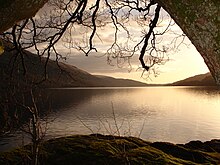
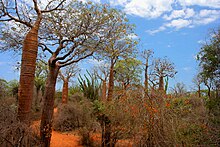
Biodiversityplays an important role in ecosystem functioning.[31]: 449–453 Ecosystem processes are driven by the species in an ecosystem, the nature of the individual species, and the relative abundance of organisms among these species. Ecosystem processes are the net effect of the actions of individual organisms as they interact with their environment.Ecological theorysuggests that in order to coexist, species must have some level oflimiting similarity—they must be different from one another in some fundamental way, otherwise, one species wouldcompetitively excludethe other.[32]Despite this, the cumulative effect of additional species in an ecosystem is not linear: additional species may enhance nitrogen retention, for example. However, beyond some level of species richness,[11]: 331 additional species may have little additive effect unless they differ substantially from species already present.[11]: 324 This is the case for example forexotic species.[11]: 321
The addition (or loss) of species that are ecologically similar to those already present in an ecosystem tends to only have a small effect on ecosystem function. Ecologically distinct species, on the other hand, have a much larger effect. Similarly, dominant species have a large effect on ecosystem function, while rare species tend to have a small effect.Keystone speciestend to have an effect on ecosystem function that is disproportionate to their abundance in an ecosystem.[11]: 324
Anecosystem engineeris anyorganismthat creates, significantly modifies, maintains or destroys ahabitat.[33]
Study approaches
Ecosystem ecology
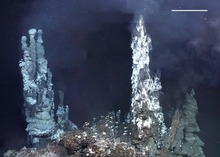
Ecosystem ecologyis the "study of the interactions between organisms and their environment as an integrated system".[2]: 458 The size of ecosystems can range up to tenorders of magnitude,from the surface layers of rocks to the surface of the planet.[4]: 6
TheHubbard Brook Ecosystem Studystarted in 1963 to study theWhite Mountains in New Hampshire.It was the first successful attempt to study an entirewatershedas an ecosystem. The study used streamchemistryas a means of monitoring ecosystem properties, and developed a detailedbiogeochemical modelof the ecosystem.[34]Long-term researchat the site led to the discovery ofacid rainin North America in 1972. Researchers documented the depletion of soilcations(especially calcium) over the next several decades.[35]
Ecosystems can be studied through a variety of approaches—theoretical studies, studies monitoring specific ecosystems over long periods of time, those that look at differences between ecosystems to elucidate how they work and direct manipulative experimentation.[36]Studies can be carried out at a variety of scales, ranging from whole-ecosystem studies to studyingmicrocosmsormesocosms(simplified representations of ecosystems).[37]American ecologistStephen R. Carpenterhas argued that microcosm experiments can be "irrelevant and diversionary" if they are not carried out in conjunction with field studies done at the ecosystem scale. In such cases, microcosm experiments may fail to accurately predict ecosystem-level dynamics.[38]
Classifications
Biomesare general classes or categories of ecosystems.[4]: 14 However, there is no clear distinction between biomes and ecosystems.[39]Biomes are always defined at a very general level. Ecosystems can be described at levels that range from very general (in which case the names are sometimes the same as those of biomes) to very specific, such as "wet coastal needle-leafed forests".
Biomes vary due to global variations inclimate.Biomes are often defined by their structure: at a general level, for example,tropical forests,temperate grasslands,and arctictundra.[4]: 14 There can be any degree of subcategories among ecosystem types that comprise a biome, e.g., needle-leafedboreal forestsor wet tropical forests. Although ecosystems are most commonly categorized by their structure and geography, there are also other ways to categorize and classify ecosystems such as by their level of human impact (seeanthropogenic biome), or by their integration with social processes or technological processes or their novelty (e.g.novel ecosystem). Each of thesetaxonomiesof ecosystems tends to emphasize different structural or functional properties.[40]None of these is the "best" classification.
Ecosystem classificationsare specific kinds of ecological classifications that consider all four elements of the definition ofecosystems:a biotic component, anabioticcomplex, the interactions between and within them, and the physical space they occupy.[40]Different approaches to ecological classifications have been developed in terrestrial, freshwater and marine disciplines, and a function-based typology has been proposed to leverage the strengths of these different approaches into a unified system.[41]
Human interactions with ecosystems
Human activities are important in almost all ecosystems. Although humans exist and operate within ecosystems, their cumulative effects are large enough to influence external factors like climate.[4]: 14
Ecosystem goods and services

Ecosystems provide a variety of goods and services upon which people depend.[42]Ecosystem goods include the "tangible, material products" of ecosystem processes such as water, food, fuel, construction material, andmedicinal plants.[43][44]They also include less tangible items liketourismand recreation, and genes from wild plants and animals that can be used to improve domestic species.[42]
Ecosystem services,on the other hand, are generally "improvements in the condition or location of things of value".[44]These include things like the maintenance of hydrological cycles, cleaning air and water, the maintenance of oxygen in the atmosphere, croppollinationand even things like beauty, inspiration and opportunities for research.[42]While material from the ecosystem had traditionally been recognized as being the basis for things of economic value, ecosystem services tend to be taken for granted.[44]
TheMillennium Ecosystem Assessmentis an international synthesis by over 1000 of the world's leading biological scientists that analyzes the state of the Earth's ecosystems and provides summaries and guidelines for decision-makers. The report identified four major categories of ecosystem services: provisioning, regulating, cultural and supporting services.[45]It concludes that human activity is having a significant and escalating impact on the biodiversity of the world ecosystems, reducing both theirresilienceandbiocapacity.The report refers to natural systems as humanity's "life-support system", providing essential ecosystem services. The assessment measures 24 ecosystem services and concludes that only four have shown improvement over the last 50 years, 15 are in serious decline, and five are in a precarious condition.[45]: 6–19
TheIntergovernmental Science-Policy Platform on Biodiversity and Ecosystem Services(IPBES) is an intergovernmental organization established to improve the interface between science and policy on issues ofbiodiversityand ecosystem services.[46][47]It is intended to serve a similar role to theIntergovernmental Panel on Climate Change.[48]
Ecosystem services are limited and also threatened by human activities.[49]To help inform decision-makers, many ecosystem services are being assigned economic values, often based on the cost of replacement with anthropogenic alternatives. The ongoing challenge of prescribing economic value to nature, for example throughbiodiversity banking,is prompting transdisciplinary shifts in how we recognize and manage the environment,social responsibility,business opportunities, and our future as a species.[49]
Degradation and decline
As human population and per capita consumption grow, so do the resource demands imposed on ecosystems and the effects of the humanecological footprint.Natural resources are vulnerable and limited. The environmental impacts ofanthropogenicactions are becoming more apparent. Problems for all ecosystems include:environmental pollution,climate changeandbiodiversity loss.For terrestrial ecosystems further threats includeair pollution,soil degradation,anddeforestation.Foraquatic ecosystemsthreats also include unsustainable exploitation of marine resources (for exampleoverfishing),marine pollution,microplasticspollution, theeffects of climate change on oceans(e.g. warming andacidification), and building on coastal areas.[50]
Many ecosystems become degraded through human impacts, such assoil loss,airandwater pollution,habitat fragmentation,water diversion,fire suppression,andintroduced speciesandinvasive species.[51]: 437
These threats can lead to abrupt transformation of the ecosystem or to gradual disruption of biotic processes and degradation ofabioticconditions of the ecosystem. Once the original ecosystem has lost its defining features, it is consideredcollapsed(see alsoIUCN Red List of Ecosystems).[52]Ecosystem collapse could be reversible and in this way differs fromspecies extinction.[53]Quantitative assessments of therisk of collapseare used as measures of conservation status and trends.
Management
Whennatural resource managementis applied to whole ecosystems, rather than single species, it is termedecosystem management.[54]Although definitions of ecosystem management abound, there is a common set of principles which underlie these definitions: A fundamental principle is the long-termsustainabilityof the production of goods and services by the ecosystem;[51]"intergenerational sustainability [is] a precondition for management, not an afterthought".[42]While ecosystem management can be used as part of a plan forwildernessconservation, it can also be used in intensively managed ecosystems[42](see, for example,agroecosystemandclose to nature forestry).
Restoration and sustainable development
Integrated conservation and development projects(ICDPs) aim to addressconservationand human livelihood (sustainable development) concerns indeveloping countriestogether, rather than separately as was often done in the past.[51]: 445
See also
Types
The following articles are types of ecosystems for particular types of regions or zones:
- Ecosystems grouped by condition
Instances
Ecosystem instances in specific regions of the world:
References
- ^Hatcher, Bruce Gordon (1990). "Coral reef primary productivity. A hierarchy of pattern and process".Trends in Ecology and Evolution.5(5): 149–155.doi:10.1016/0169-5347(90)90221-X.PMID21232343.
- ^abcdeChapin, F. Stuart III (2011). "Glossary".Principles of terrestrial ecosystem ecology.P. A. Matson, Peter Morrison Vitousek, Melissa C. Chapin (2nd ed.). New York: Springer.ISBN978-1-4419-9504-9.OCLC755081405.
- ^abcTansley, A. G. (1935)."The Use and Abuse of Vegetational Concepts and Terms"(PDF).Ecology.16(3): 284–307.Bibcode:1935Ecol...16..284T.doi:10.2307/1930070.JSTOR1930070.Archived fromthe original(PDF)on 2016-10-06.
- ^abcdefghijChapin, F. Stuart III (2011). "Chapter 1: The Ecosystem Concept".Principles of terrestrial ecosystem ecology.P. A. Matson, Peter Morrison Vitousek, Melissa C. Chapin (2nd ed.). New York: Springer.ISBN978-1-4419-9504-9.OCLC755081405.
- ^Odum, Eugene P (1971).Fundamentals of Ecology(third ed.). New York: Saunders.ISBN978-0-534-42066-6.
- ^Willis, A.J. (1997)."The Ecosystem: An Evolving Concept Viewed Historically".Functional Ecology.11(2): 268–271.doi:10.1111/j.1365-2435.1997.00081.x.
- ^Tansley, A.G.(1939).The British Islands and Their Vegetation.Cambridge University Press.
- ^abcChapin, F. Stuart III (2011). "Chapter 5: Carbon Inputs to Ecosystems".Principles of terrestrial ecosystem ecology.P. A. Matson, Peter Morrison Vitousek, Melissa C. Chapin (2nd ed.). New York: Springer.ISBN978-1-4419-9504-9.OCLC755081405.
- ^Chapin, F. Stuart III (2011). "Chapter 2: Earth's Climate System".Principles of terrestrial ecosystem ecology.P. A. Matson, Peter Morrison Vitousek, Melissa C. Chapin (2nd ed.). New York: Springer.ISBN978-1-4419-9504-9.OCLC755081405.
- ^abChapin, F. Stuart III (2011). "Chapter 3: Geology, Soils, and Sediments".Principles of terrestrial ecosystem ecology.P. A. Matson, Peter Morrison Vitousek, Melissa C. Chapin (2nd ed.). New York: Springer.ISBN978-1-4419-9504-9.OCLC755081405.
- ^abcdeChapin, F. Stuart III (2011). "Chapter 11: Species Effects on Ecosystem Processes".Principles of terrestrial ecosystem ecology.P. A. Matson, Peter Morrison Vitousek, Melissa C. Chapin (2nd ed.). New York: Springer.ISBN978-1-4419-9504-9.OCLC755081405.
- ^Simberloff, Daniel; Martin, Jean-Louis; Genovesi, Piero; Maris, Virginie; Wardle, David A.; Aronson, James; Courchamp, Franck; Galil, Bella; García-Berthou, Emili (2013). "Impacts of biological invasions: what's what and the way forward".Trends in Ecology & Evolution.28(1): 58–66.doi:10.1016/j.tree.2012.07.013.hdl:10261/67376.ISSN0169-5347.PMID22889499.
- ^"46.1A: Ecosystem Dynamics".Biology LibreTexts.2018-07-17.Archivedfrom the original on 2021-08-02.Retrieved2021-08-02.

 Text was copied from this source, which is available under aCreative Commons Attribution 4.0 International LicenseArchived2017-10-16 at theWayback Machine.
Text was copied from this source, which is available under aCreative Commons Attribution 4.0 International LicenseArchived2017-10-16 at theWayback Machine.
- ^abcdChapin, F. Stuart III (2011). "Chapter 6: Plant Carbon Budgets".Principles of terrestrial ecosystem ecology.P. A. Matson, Peter Morrison Vitousek, Melissa C. Chapin (2nd ed.). New York: Springer.ISBN978-1-4419-9504-9.OCLC755081405.
- ^abcdChapin, F. Stuart III (2011). "Chapter 10: Trophic Dynamics".Principles of terrestrial ecosystem ecology.P. A. Matson, Peter Morrison Vitousek, Melissa C. Chapin (2nd ed.). New York: Springer.ISBN978-1-4419-9504-9.OCLC755081405.
- ^Yvon-Durocher, Gabriel; Caffrey, Jane M.; Cescatti, Alessandro; Dossena, Matteo; Giorgio, Paul del; Gasol, Josep M.; Montoya, José M.; Pumpanen, Jukka; Staehr, Peter A. (2012). "Reconciling the temperature dependence of respiration across timescales and ecosystem types".Nature.487(7408): 472–476.Bibcode:2012Natur.487..472Y.doi:10.1038/nature11205.ISSN0028-0836.PMID22722862.S2CID4422427.
- ^Lovett, Gary M.; Cole, Jonathan J.; Pace, Michael L. (2006). "Is Net Ecosystem Production Equal to Ecosystem Carbon Accumulation?".Ecosystems.9(1): 152–155.Bibcode:2006Ecosy...9..152L.doi:10.1007/s10021-005-0036-3.ISSN1435-0629.S2CID5890190.
- ^abcdefChapin, F. Stuart III (2011). "Chapter 7: Decomposition and Ecosystem Carbon Budgets".Principles of terrestrial ecosystem ecology.P. A. Matson, Peter Morrison Vitousek, Melissa C. Chapin (2nd ed.). New York: Springer.ISBN978-1-4419-9504-9.OCLC755081405.
- ^abcdefghijChapin, F. Stuart III (2011). "Chapter 9: Nutrient cycling".Principles of terrestrial ecosystem ecology.P. A. Matson, Peter Morrison Vitousek, Melissa C. Chapin (2nd ed.). New York: Springer.ISBN978-1-4419-9504-9.OCLC755081405.
- ^Ochoa-Hueso, R; Delgado-Baquerizo, M; King, PTA; Benham, M; Arca, V; Power, SA (February 2019). "Ecosystem type and resource quality are more important than global change drivers in regulating early stages of litter decomposition".Soil Biology and Biochemistry.129:144–152.doi:10.1016/j.soilbio.2018.11.009.hdl:10261/336676.S2CID92606851.
- ^abcdeChapin, F. Stuart III (2011). "Chapter 12: Temporal Dynamics".Principles of terrestrial ecosystem ecology.P. A. Matson, Peter Morrison Vitousek, Melissa C. Chapin (2nd ed.). New York: Springer.ISBN978-1-4419-9504-9.OCLC755081405.
- ^Chapin, F. Stuart III; Kofinas, Gary P.; Folke, Carl; Chapin, Melissa C., eds. (2009).Principles of ecosystem stewardship: resilience-based natural resource management in a changing world(1st ed.). New York: Springer.ISBN978-0-387-73033-2.OCLC432702920.
- ^Walker, Brian; Holling, C. S.; Carpenter, Stephen R.; Kinzig, Ann P. (2004)."Resilience, Adaptability and Transformability in Social-ecological Systems".Ecology and Society.9(2): art5.doi:10.5751/ES-00650-090205.hdl:10535/3282.ISSN1708-3087.Archivedfrom the original on 2019-05-17.Retrieved2021-07-23.
- ^Simonsen, S.H."Applying Resilience Thinking"(PDF).Stockholm Resilience Centre.Archived(PDF)from the original on 2017-12-15.
- ^Walter, K. M.; Zimov, S. A.; Chanton, J. P.; Verbyla, D.; Chapin, F. S. (2006)."Methane bubbling from Siberian thaw lakes as a positive feedback to climate warming"(PDF).Nature.443(7107): 71–75.Bibcode:2006Natur.443...71W.doi:10.1038/nature05040.ISSN0028-0836.PMID16957728.S2CID4415304.Archived fromthe original(PDF)on Nov 23, 2011.Retrieved2021-08-16.
- ^Vitousek, P.; Porder, S. (2010)."Terrestrial phosphorus limitation: mechanisms, implications, and nitrogen–phosphorus interactions".Ecological Applications.20(1): 5–15.Bibcode:2010EcoAp..20....5V.doi:10.1890/08-0127.1.PMID20349827.
- ^abChapin, F. Stuart III (2011). "Chapter 8: Plant Nutrient Use".Principles of terrestrial ecosystem ecology.P. A. Matson, Peter Morrison Vitousek, Melissa C. Chapin (2nd ed.). New York: Springer.ISBN978-1-4419-9504-9.OCLC755081405.
- ^Bolan, N.S. (1991). "A critical review on the role of mycorrhizal fungi in the uptake of phosphorus by plants".Plant and Soil.134(2): 189–207.Bibcode:1991PlSoi.134..189B.doi:10.1007/BF00012037.S2CID44215263.
- ^abHestrin, R.; Hammer, E.C.; Mueller, C.W. (2019)."Synergies between mycorrhizal fungi and soil microbial communities increase plant nitrogen acquisition".Commun Biol.2:233.doi:10.1038/s42003-019-0481-8.PMC6588552.PMID31263777.
- ^Adams, C.E. (1994)."The fish community of Loch Lomond, Scotland: its history and rapidly changing status".Hydrobiologia.290(1–3): 91–102.doi:10.1007/BF00008956.S2CID6894397.
- ^Schulze, Ernst-Detlef; Erwin Beck; Klaus Müller-Hohenstein (2005).Plant Ecology.Berlin: Springer.ISBN978-3-540-20833-4.
- ^Schoener, Thomas W. (2009). "Ecological Niche". InSimon A. Levin(ed.).The Princeton Guide to Ecology.Princeton: Princeton University Press. pp.2–13.ISBN978-0-691-12839-9.
- ^Jones, Clive G.; Lawton, John H.; Shachak, Moshe (1994). "Organisms as Ecosystem Engineers".Oikos.69(3): 373–386.Bibcode:1994Oikos..69..373J.doi:10.2307/3545850.ISSN0030-1299.JSTOR3545850.
- ^Lindenmayer, David B.; Gene E. Likens (2010). "The Problematic, the Effective and the Ugly – Some Case Studies".Effective Ecological Monitoring.Collingwood, Australia: CSIRO Publishing. pp. 87–145.ISBN978-1-84971-145-6.
- ^Likens, Gene E. (2004)."Some perspectives on long-term biogeochemical research from the Hubbard Brook Ecosystem Study"(PDF).Ecology.85(9): 2355–2362.Bibcode:2004Ecol...85.2355L.doi:10.1890/03-0243.JSTOR3450233.Archived fromthe original(PDF)on 2013-05-01.
- ^Carpenter, Stephen R.; Jonathan J. Cole; Timothy E. Essington; James R. Hodgson; Jeffrey N. Houser; James F. Kitchell; Michael L. Pace (1998)."Evaluating Alternative Explanations in Ecosystem Experiments".Ecosystems.1(4): 335–344.Bibcode:1998Ecosy...1..335C.doi:10.1007/s100219900025.S2CID33559404.
- ^Schindler, David W. (1998). "Replication versus Realism: The Need for Ecosystem-Scale Experiments".Ecosystems.1(4): 323–334.doi:10.1007/s100219900026.JSTOR3658915.S2CID45418039.
- ^Carpenter, Stephen R. (1996). "Microcosm Experiments have Limited Relevance for Community and Ecosystem Ecology".Ecology.77(3): 677–680.Bibcode:1996Ecol...77..677C.doi:10.2307/2265490.JSTOR2265490.
- ^"Differences Between the Grassland & the Tundra".Sciencing.Archivedfrom the original on 2021-07-16.Retrieved2021-07-16.
- ^abKeith, D.A.; Ferrer-Paris, J.R.; Nicholson, E.; Kingsford, R.T., eds. (2020).The IUCN Global Ecosystem Typology 2.0: Descriptive profiles for biomes and ecosystem functional groups.Gland, Switzerland: IUCN.doi:10.2305/IUCN.CH.2020.13.en.ISBN978-2-8317-2077-7.S2CID241360441.
- ^Keith, David A.; Ferrer-Paris, José R.; Nicholson, Emily; Bishop, Melanie J.; Polidoro, Beth A.; Ramirez-Llodra, Eva; Tozer, Mark G.; Nel, Jeanne L.; Mac Nally, Ralph; Gregr, Edward J.; Watermeyer, Kate E.; Essl, Franz; Faber-Langendoen, Don; Franklin, Janet; Lehmann, Caroline E. R.; Etter, Andrés; Roux, Dirk J.; Stark, Jonathan S.; Rowland, Jessica A.; Brummitt, Neil A.; Fernandez-Arcaya, Ulla C.; Suthers, Iain M.; Wiser, Susan K.; Donohue, Ian; Jackson, Leland J.; Pennington, R. Toby; Iliffe, Thomas M.; Gerovasileiou, Vasilis; Giller, Paul; Robson, Belinda J.; Pettorelli, Nathalie; Andrade, Angela; Lindgaard, Arild; Tahvanainen, Teemu; Terauds, Aleks; Chadwick, Michael A.; Murray, Nicholas J.; Moat, Justin; Pliscoff, Patricio; Zager, Irene; Kingsford, Richard T. (12 October 2022)."A function-based typology for Earth's ecosystems".Nature.610(7932): 513–518.Bibcode:2022Natur.610..513K.doi:10.1038/s41586-022-05318-4.PMC9581774.PMID36224387.
- ^abcdeChristensen, Norman L.; Bartuska, Ann M.; Brown, James H.; Carpenter, Stephen; D'Antonio, Carla; Francis, Robert; Franklin, Jerry F.; MacMahon, James A.; Noss, Reed F.; Parsons, David J.; Peterson, Charles H.; Turner, Monica G.; Woodmansee, Robert G. (1996). "The Report of the Ecological Society of America Committee on the Scientific Basis for Ecosystem Management".Ecological Applications.6(3): 665–691.Bibcode:1996EcoAp...6..665C.CiteSeerX10.1.1.404.4909.doi:10.2307/2269460.JSTOR2269460.S2CID53461068.
- ^"Ecosystem Goods and Services"(PDF).Archived(PDF)from the original on 2009-11-10.
- ^abcBrown, Thomas C.; John C. Bergstrom; John B. Loomis (2007)."Defining, valuing and providing ecosystem goods and services"(PDF).Natural Resources Journal.47(2): 329–376. Archived fromthe original(PDF)on 2013-05-25.
- ^ab"Millennium Ecosystem Assessment".2005.Archivedfrom the original on 2011-05-24.Retrieved10 November2021.
- ^"IPBES".Archived fromthe originalon 27 June 2019.Retrieved28 June2019.
- ^Díaz, Sandra; Demissew, Sebsebe; Carabias, Julia; Joly, Carlos; Lonsdale, Mark; Ash, Neville; Larigauderie, Anne; Adhikari, Jay Ram; Arico, Salvatore; Báldi, András; Bartuska, Ann (2015)."The IPBES Conceptual Framework — connecting nature and people".Current Opinion in Environmental Sustainability.14:1–16.Bibcode:2015COES...14....1D.doi:10.1016/j.cosust.2014.11.002.hdl:11336/56765.S2CID14000233.
- ^"Biodiversity crisis is worse than climate change, experts say".ScienceDaily.January 20, 2012.Archivedfrom the original on December 29, 2021.RetrievedSeptember 11,2019.
- ^abCeccato, Pietro; Fernandes, Katia; Ruiz, Daniel; Allis, Erica (17 June 2014)."Climate and environmental monitoring for decision making".Earth Perspectives.1(1): 16.Bibcode:2014EarP....1...16C.doi:10.1186/2194-6434-1-16.S2CID46200068.
- ^Alexander, David E. (1 May 1999).Encyclopedia of Environmental Science.Springer.ISBN978-0-412-74050-3.
- ^abcChapin, F. Stuart III (2011). "Chapter 15: Managing and Sustaining Ecosystems".Principles of terrestrial ecosystem ecology.P. A. Matson, Peter Morrison Vitousek, Melissa C. Chapin (2nd ed.). New York: Springer.ISBN978-1-4419-9504-9.OCLC755081405.
- ^Keith, DA; Rodríguez, J.P.; Rodríguez-Clark, K.M.; Aapala, K.; Alonso, A.; Asmussen, M.; Bachman, S.; Bassett, A.; Barrow, E.G.; Benson, J.S.; Bishop, M.J.; Bonifacio, R.; Brooks, T.M.; Burgman, M.A.; Comer, P.; Comín, F.A.; Essl, F.; Faber-Langendoen, D.; Fairweather, P.G.; Holdaway, R.J.; Jennings, M.; Kingsford, R.T.; Lester, R.E.; Mac Nally, R.; McCarthy, M.A.; Moat, J.; Nicholson, E.; Oliveira-Miranda, M.A.; Pisanu, P.; Poulin, B.; Riecken, U.; Spalding, M.D.; Zambrano-Martínez, S. (2013)."Scientific Foundations for an IUCN Red List of Ecosystems".PLOS ONE.8(5): e62111.Bibcode:2013PLoSO...862111K.doi:10.1371/journal.pone.0062111.PMC3648534.PMID23667454.
- ^Boitani, Luigi; Mace, Georgina M.; Rondinini, Carlo (2014)."Challenging the Scientific Foundations for an IUCN Red List of Ecosystems"(PDF).Conservation Letters.8(2): 125–131.doi:10.1111/conl.12111.hdl:11573/624610.S2CID62790495.Archived(PDF)from the original on 2018-07-22.Retrieved2021-01-06.

- ^Grumbine, R. Edward (1994)."What is ecosystem management?"(PDF).Conservation Biology.8(1): 27–38.Bibcode:1994ConBi...8...27G.doi:10.1046/j.1523-1739.1994.08010027.x.Archived fromthe original(PDF)on 2013-05-02.
External links
 Media related toEcosystemsat Wikimedia Commons
Media related toEcosystemsat Wikimedia Commons The dictionary definition ofecosystemat Wiktionary
The dictionary definition ofecosystemat Wiktionary- Wikidata:topic(Scholia)
 Biomes and ecosystemstravel guide from Wikivoyage
Biomes and ecosystemstravel guide from Wikivoyage

